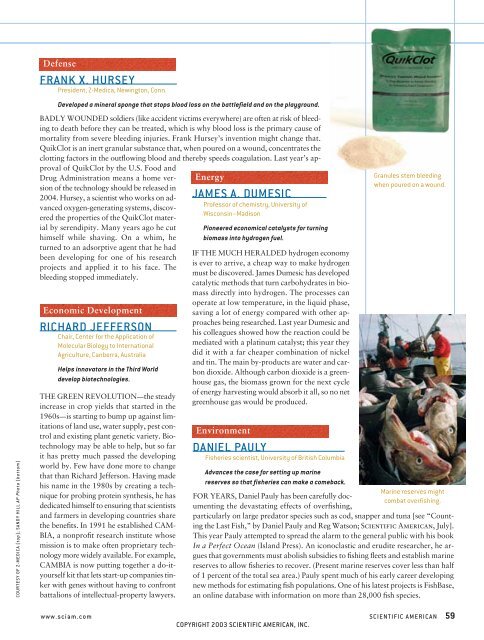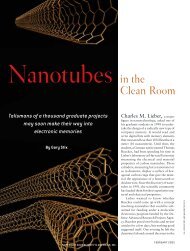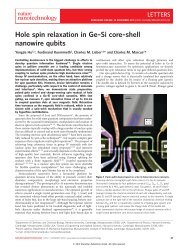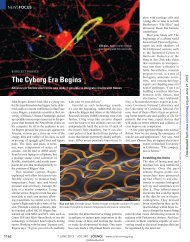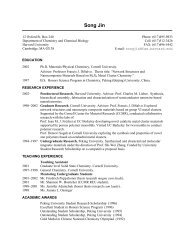download pdf - Lieber Research Group - Harvard University
download pdf - Lieber Research Group - Harvard University
download pdf - Lieber Research Group - Harvard University
You also want an ePaper? Increase the reach of your titles
YUMPU automatically turns print PDFs into web optimized ePapers that Google loves.
COURTESY OF Z-MEDICA (top); SANDY HILL AP Photo ( bottom)<br />
Defense<br />
FRANK X. HURSEY<br />
President, Z-Medica, Newington, Conn.<br />
Developed a mineral sponge that stops blood loss on the battlefield and on the playground.<br />
BADLY WOUNDED soldiers (like accident victims everywhere) are often at risk of bleeding<br />
to death before they can be treated, which is why blood loss is the primary cause of<br />
mortality from severe bleeding injuries. Frank Hursey’s invention might change that.<br />
QuikClot is an inert granular substance that, when poured on a wound, concentrates the<br />
clotting factors in the outflowing blood and thereby speeds coagulation. Last year’s approval<br />
of QuikClot by the U.S. Food and<br />
Drug Administration means a home version<br />
of the technology should be released in<br />
Energy<br />
2004. Hursey, a scientist who works on advanced<br />
oxygen-generating systems, discov-<br />
JAMES A. DUMESIC<br />
Professor of chemistry, <strong>University</strong> of<br />
Wisconsin–Madison<br />
ered the properties of the QuikClot material<br />
by serendipity. Many years ago he cut<br />
Pioneered economical catalysts for turning<br />
himself while shaving. On a whim, he<br />
biomass into hydrogen fuel.<br />
turned to an adsorptive agent that he had<br />
been developing for one of his research<br />
projects and applied it to his face. The<br />
bleeding stopped immediately.<br />
Economic Development<br />
RICHARD JEFFERSON<br />
Chair, Center for the Application of<br />
Molecular Biology to International<br />
Agriculture, Canberra, Australia<br />
Helps innovators in the Third World<br />
develop biotechnologies.<br />
THE GREEN REVOLUTION—the steady<br />
increase in crop yields that started in the<br />
1960s—is starting to bump up against limitations<br />
of land use, water supply, pest control<br />
and existing plant genetic variety. Biotechnology<br />
may be able to help, but so far<br />
it has pretty much passed the developing<br />
world by. Few have done more to change<br />
that than Richard Jefferson. Having made<br />
his name in the 1980s by creating a technique<br />
for probing protein synthesis, he has<br />
dedicated himself to ensuring that scientists<br />
and farmers in developing countries share<br />
the benefits. In 1991 he established CAM-<br />
BIA, a nonprofit research institute whose<br />
mission is to make often proprietary technology<br />
more widely available. For example,<br />
CAMBIA is now putting together a do-ityourself<br />
kit that lets start-up companies tinker<br />
with genes without having to confront<br />
battalions of intellectual-property lawyers.<br />
IF THE MUCH HERALDED hydrogen economy<br />
is ever to arrive, a cheap way to make hydrogen<br />
must be discovered. James Dumesic has developed<br />
catalytic methods that turn carbohydrates in biomass<br />
directly into hydrogen. The processes can<br />
operate at low temperature, in the liquid phase,<br />
saving a lot of energy compared with other approaches<br />
being researched. Last year Dumesic and<br />
his colleagues showed how the reaction could be<br />
mediated with a platinum catalyst; this year they<br />
did it with a far cheaper combination of nickel<br />
and tin. The main by-products are water and carbon<br />
dioxide. Although carbon dioxide is a greenhouse<br />
gas, the biomass grown for the next cycle<br />
of energy harvesting would absorb it all, so no net<br />
greenhouse gas would be produced.<br />
Environment<br />
DANIEL PAULY<br />
Fisheries scientist, <strong>University</strong> of British Columbia<br />
Advances the case for setting up marine<br />
reserves so that fisheries can make a comeback.<br />
FOR YEARS, Daniel Pauly has been carefully documenting<br />
the devastating effects of overfishing,<br />
Granules stem bleeding<br />
when poured on a wound.<br />
Marine reserves might<br />
combat overfishing.<br />
particularly on large predator species such as cod, snapper and tuna [see “Counting<br />
the Last Fish,” by Daniel Pauly and Reg Watson; Scientific American, July].<br />
This year Pauly attempted to spread the alarm to the general public with his book<br />
In a Perfect Ocean (Island Press). An iconoclastic and erudite researcher, he argues<br />
that governments must abolish subsidies to fishing fleets and establish marine<br />
reserves to allow fisheries to recover. (Present marine reserves cover less than half<br />
of 1 percent of the total sea area.) Pauly spent much of his early career developing<br />
new methods for estimating fish populations. One of his latest projects is FishBase,<br />
an online database with information on more than 28,000 fish species.<br />
www.sciam.com SCIENTIFIC AMERICAN 59<br />
COPYRIGHT 2003 SCIENTIFIC AMERICAN, INC.


